You are using an out of date browser. It may not display this or other websites correctly.
You should upgrade or use an alternative browser.
You should upgrade or use an alternative browser.
I'd say almost any of them would if properly sealed and balanced. You would have to be very careful about getting both halves equal during construction and then add ballast low down.
My scratch build would float if I wanted it to. It will stand upright on the keel so is perfectly balanced at the moment. I would just need to add waterproof sealer to the hull.
My scratch build would float if I wanted it to. It will stand upright on the keel so is perfectly balanced at the moment. I would just need to add waterproof sealer to the hull.
If you Google up Radio Control model boats you will find a number of different vessels but primarily fore and aft rigged like schooners of various types and some of those RC YouTube guys also sell their boats as kits. There are whole clubs of pond sailers and racers around the country. Rich (PT-2)I'd say almost any of them would if properly sealed and balanced. You would have to be very careful about getting both halves equal during construction and then add ballast low down.
My scratch build would float if I wanted it to. It will stand upright on the keel so is perfectly balanced at the moment. I would just need to add waterproof sealer to the hull.
Thanks for input. I am new in ship building. Actually just finished my first built, a Shipways Armed Longboat. Would you help me decide between a Mayflower and a Lady Nelson. Or you may want to suggest/recommend for my 2nd built? Thank you.I'd say almost any of them would if properly sealed and balanced. You would have to be very careful about getting both halves equal during construction and then add ballast low down.
My scratch build would float if I wanted it to. It will stand upright on the keel so is perfectly balanced at the moment. I would just need to add waterproof sealer to the hull.
If you saw the RC sailboats you will see that they all have long extended daggerboard with a weight on the bottom. The boat may look correct above the water but it will have the added daggerboard for stability. RichThanks for input. I am new in ship building. Actually just finished my first built, a Shipways Armed Longboat. Would you help me decide between a Mayflower and a Lady Nelson. Or you may want to suggest/recommend for my 2nd built? Thank you.
Right. I've owned an RC Yamaha sailboat boat. It's not heavily ballast but hss a deep.keel. I wonder what model builders used as ballasting/weights materials? Is it better to get a model with molded hull than wooden plank-in if intended to float? Thanks
From what I saw on some YouTube RC boats it was an aluminum dagger-board right out of the keel with a shaped lead end weight. I saw both planked with fiberglass and fiberglass molded over a planked hull and then removed for the boats.Right. I've owned an RC Yamaha sailboat boat. It's not heavily ballast but hss a deep.keel. I wonder what model builders used as ballasting/weights materials? Is it better to get a model with molded hull than wooden plank-in if intended to float? Thanks
I'm not the one to recommend a kit as I have only ever built one - the Shipways Longboat. But there are many experienced kit builders on here who can advise you. Good luck.Thanks for input. I am new in ship building. Actually just finished my first built, a Shipways Armed Longboat. Would you help me decide between a Mayflower and a Lady Nelson. Or you may want to suggest/recommend for my 2nd built? Thank you.
Like you, Shipways Armed Longboat is also my first built.I'm not the one to recommend a kit as I have only ever built one - the Shipways Longboat. But there are many experienced kit builders on here who can advise you. Good luck.
There is a problem with trying to build a working model of a sailing ship. As you scale them down the volume of the hull decreases as a cube(the hull has three dimensions) but the sails decrease as a square(sails basically have two dimensions) so you end up with way more sail area than righting moment( the wind knocks the ship over). You can't just add ballast as the ship will sail too low in the water. This is a real problem with a fore and aft rig because the sail has to be too small to look right or the hull has to be too big to look right. Square rigged may not be as much of a problem as you can reduce the number of sail and it can still look scale. When I built the Cicely schooner I used a fin keel about 18" deep with a 5 lb. bulb on it. I painted them black so they didn't show that much but it still steals from the effect when you lift it out of the water.
Just something to keep in mind about working model sailing ships. Physics is not your friend
Just something to keep in mind about working model sailing ships. Physics is not your friend
Two things that cannot be scaled down if the "material" remains the same: water and air each have their own viscosity factors that will affect any scale down changed model. Of course you could substitute another fluid for water to scale the viscosity better matching the model boat but I don't know how you could change air/wind . . . you will have to work with what you have control over and accept what you cannot IMHO. Just a thought. Rich (PT-2)There is a problem with trying to build a working model of a sailing ship. As you scale them down the volume of the hull decreases as a cube(the hull has three dimensions) but the sails decrease as a square(sails basically have two dimensions) so you end up with way more sail area than righting moment( the wind knocks the ship over). You can't just add ballast as the ship will sail too low in the water. This is a real problem with a fore and aft rig because the sail has to be too small to look right or the hull has to be too big to look right. Square rigged may not be as much of a problem as you can reduce the number of sail and it can still look scale. When I built the Cicely schooner I used a fin keel about 18" deep with a 5 lb. bulb on it. I painted them black so they didn't show that much but it still steals from the effect when you lift it out of the water.
Just something to keep in mind about working model sailing ships. Physics is not your friend
Physics has NEVER been my friend. Hence my naive suggestion that floating a kit model would probably be okay. Although it is never going to be my intention to try to float a model I'm pleased you set the record straight for others to ponder.There is a problem with trying to build a working model of a sailing ship. As you scale them down the volume of the hull decreases as a cube(the hull has three dimensions) but the sails decrease as a square(sails basically have two dimensions) so you end up with way more sail area than righting moment( the wind knocks the ship over). You can't just add ballast as the ship will sail too low in the water. This is a real problem with a fore and aft rig because the sail has to be too small to look right or the hull has to be too big to look right. Square rigged may not be as much of a problem as you can reduce the number of sail and it can still look scale. When I built the Cicely schooner I used a fin keel about 18" deep with a 5 lb. bulb on it. I painted them black so they didn't show that much but it still steals from the effect when you lift it out of the water.
Just something to keep in mind about working model sailing ships. Physics is not your friend
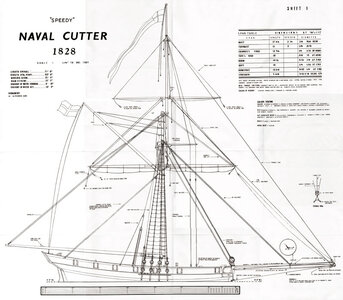
I built The Cutter from the plans of I think it was Bill Shoulder, the plans were to a scale of 1/48 but as i wanted to sail it on the pond I double the size to 1/24,
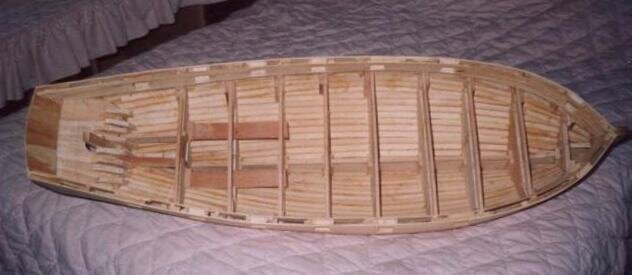
These next few pics show the construction,
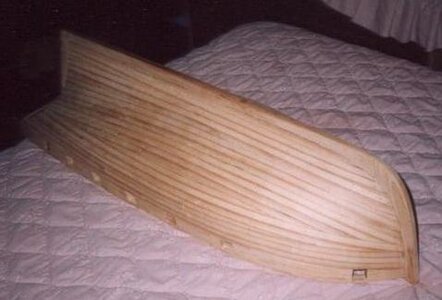
I used a very light wood, I believe it was cedar to keep the weight of the cutter down,
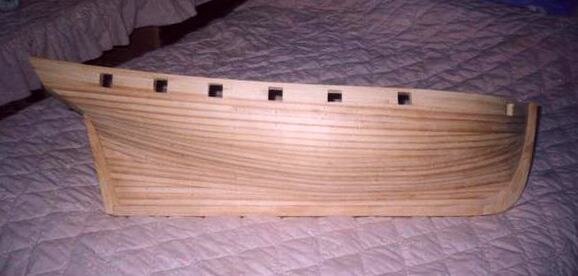
now this hull is as per the plan, no extensions yet as i wanted to see if I could sail it with internal ballast,
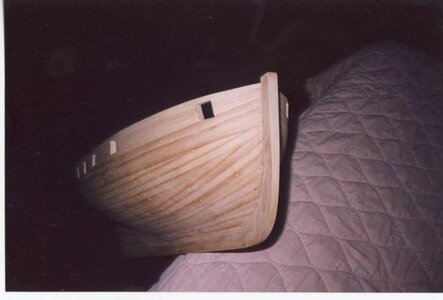
Bow view,
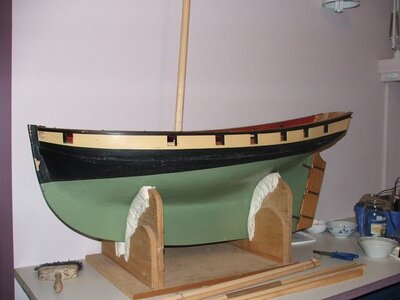
However after trialing internal ballast, I had to resort to extending the keel, here you can see the difference in depth, I was going to have the keel as a bolt on but there were too many complications for me, so i made a framework the thickness of the keel, which i then cast white metal into it and after the material had set I then drilled several holes through it and using long screws attached to the keel, due to the depth of our local pond i couldn't use a bulb keel, I also increased the rudder size for better handling, hope I'm not hijacking this thread if so I can move it some where else,
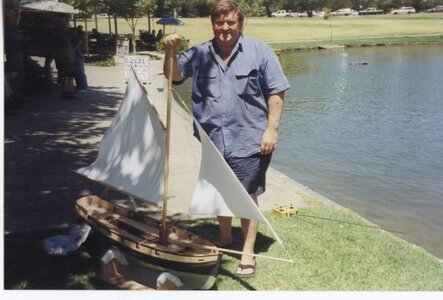
and at the pond she is just Jury rigged to test her out,
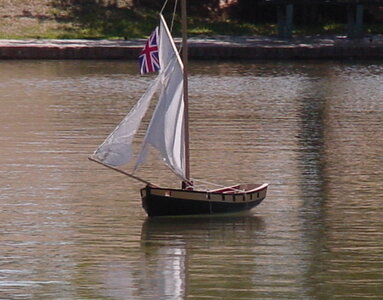
she sits nicely and when coming about she doesn't flit around she sort of just sits and when the wind is right she comes about,
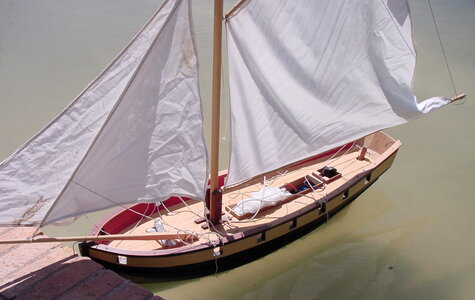
she is shown here with a hinged mast which I have since removed and the bowsprit also reeves through the bulwark,
I hope this helps anyone reading or thinking of building a sailing ship whether kit or scratch,
I forgot to mention that I did fibre glass the hull on the out side,
best regards John
Last edited:
For any seriously interested in the actual factors of the resistance (friction drag) of air and water upon a sail or hull I would refer them to (my copy 1964, not the latest) of, Sailing Theory and Practice, by C. J. Marchaj where the coefficients of friction, known as Reynolds' Numbers are presented mathematically and diagrams: Air/sails pp 84-90' which then continues with examination of masts, spreaders, etc. . For hulls and water it is presented in pp 235-41.Physics has NEVER been my friend. Hence my naive suggestion that floating a kit model would probably be okay. Although it is never going to be my intention to try to float a model I'm pleased you set the record straight for others to ponder.
Summarily, a Reynolds Number is determined by three factors describing the flow of the medium:
1. Velocity in ft/sec V
2. A characteristic length in feet l
3. A coefficient describing the viscosity and density of the medium at hand y
Re=(vl)/y
Sea Water has a different viscosity than Fresh Water. Density of the medium, say air, is dependent upon factors including temperature and humidity, as well as elevation as pilots well know but they leave concern for Reynolds' numbers up to the designer of airfoils, setting icing aside which is critically to be avoided at all times and the design airfoils restored by a number of different methods.
For very serious competitive racing craft Reynolds' numbers become very essential to those in the positioning and balancing of the center of effort of the sails above the center of resistance of the submersed hull and keel. Both are continually changing and require a sensitive touch of the helmsman or the computer controls of a large aircraft. (Personal thought is that not very many commercial pilots now have significant hands on flying skills as most of the flight is controlled by computers . . . unless they have their own small aircraft and a lot of logged hours in those. Sorry to bend the nose of some SoS commercial pilots from an unlicensed sideliner.)
As hobby model builders we have no need for the above other than personal interest unless someone is very seriously desiring to scratch build a controllable (say RC) "pond boat" which may be of sufficient size and equipage to sail in open water.
Now, back to your table and model build. Rich (PT-2)
For the construction, visual only with some nice music accompanyment here is a short YouTube video of a RC Bluenose.For any seriously interested in the actual factors of the resistance (friction drag) of air and water upon a sail or hull I would refer them to (my copy 1964, not the latest) of, Sailing Theory and Practice, by C. J. Marchaj where the coefficients of friction, known as Reynolds' Numbers are presented mathematically and diagrams: Air/sails pp 84-90' which then continues with examination of masts, spreaders, etc. . For hulls and water it is presented in pp 235-41.
Summarily, a Reynolds Number is determined by three factors describing the flow of the medium:
1. Velocity in ft/sec V
2. A characteristic length in feet l
3. A coefficient describing the viscosity and density of the medium at hand y
Re=(vl)/y
Sea Water has a different viscosity than Fresh Water. Density of the medium, say air, is dependent upon factors including temperature and humidity, as well as elevation as pilots well know but they leave concern for Reynolds' numbers up to the designer of airfoils, setting icing aside which is critically to be avoided at all times and the design airfoils restored by a number of different methods.
For very serious competitive racing craft Reynolds' numbers become very essential to those in the positioning and balancing of the center of effort of the sails above the center of resistance of the submersed hull and keel. Both are continually changing and require a sensitive touch of the helmsman or the computer controls of a large aircraft. (Personal thought is that not very many commercial pilots now have significant hands on flying skills as most of the flight is controlled by computers . . . unless they have their own small aircraft and a lot of logged hours in those. Sorry to bend the nose of some SoS commercial pilots from an unlicensed sideliner.)
As hobby model builders we have no need for the above other than personal interest unless someone is very seriously desiring to scratch build a controllable (say RC) "pond boat" which may be of sufficient size and equipage to sail in open water.
Now, back to your table and model build. Rich (PT-2)
And for a square rigger that looks like a model . . . . sailing but very light wind:For the construction, visual only with some nice music accompanyment here is a short YouTube video of a RC Bluenose.
Rich
And a parting offering from 2021 with guns and allAnd for a square rigger that looks like a model . . . . sailing but very light wind:
Rich
its done, its expensive.. even seen over the years 3 deckers done to sail on a pond or indoor pool. It may perhaps be better to find one of those older generation, and lower cost plastic ship kits airfix and revell used to do. Build one, then fit in a plastic tub compartment for controllers if you want to rc it, then fill the rest in with foam in a can..
Be careful what foam you use, some state that they are not recommended for buoyancy,its done, its expensive.. even seen over the years 3 deckers done to sail on a pond or indoor pool. It may perhaps be better to find one of those older generation, and lower cost plastic ship kits airfix and revell used to do. Build one, then fit in a plastic tub compartment for controllers if you want to rc it, then fill the rest in with foam in a can..
Best regards John,
Happy new year to everyone
coming to this party a lil late, but a couple of things I did.
I used BB’s ( used with toy air guns ) they’re small with good weight. They fit anywhere and can balance your boat easily. Once balanced, pour in 2 part epoxy, enough to submerge them to hold them in place. Make sure to place them in the lowest part of the hull.
I used 3/4 oz fibreglass to wrap the hull with 2 part epoxy for water proofing.
Neptune, very nicely finished boat !
coming to this party a lil late, but a couple of things I did.
I used BB’s ( used with toy air guns ) they’re small with good weight. They fit anywhere and can balance your boat easily. Once balanced, pour in 2 part epoxy, enough to submerge them to hold them in place. Make sure to place them in the lowest part of the hull.
I used 3/4 oz fibreglass to wrap the hull with 2 part epoxy for water proofing.
Neptune, very nicely finished boat !






